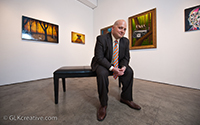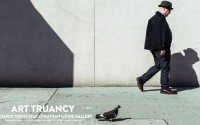JAMES MARSHALL KEEPS IT VERY REAL
Trusting your gut is easier said than done, but James Marshall has learned to have faith in his own instincts, constantly exploring new territory. From his signature Space Monkey character to his Minimalist studies of color relationships, his trajectory as a painter has been powerful and influential. Dalek, as he is known, has honed a skill for geometric perfection, and after a break from exhibits, he’s back, with a piercing vision.
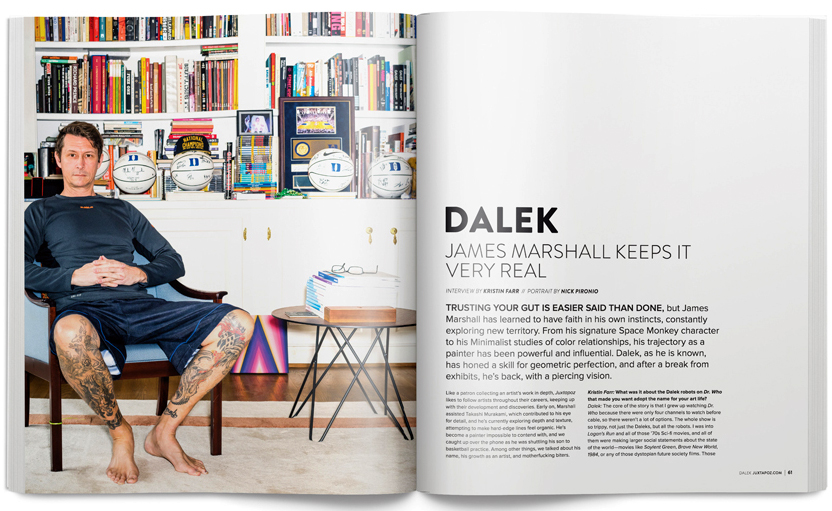
Like a patron collecting an artist’s work in depth, Juxtapoz likes to follow artists throughout their careers, keeping up with their development and discoveries. Early on, Marshall assisted Takashi Murakami, which contributed to his eye for detail, and he’s currently exploring depth and texture, attempting to make hard-edge lines feel organic. He’s become a painter impossible to contend with, and we caught up over the phone as he was shuttling his son to basketball practice. Among other things, we talked about his name, his growth as an artist, and motherfucking biters.
Kristin Farr: Graffiti is such a good training ground for painters.
Dalek: Absolutely. I was lucky enough that, when I got into graffiti, I had people who looked at it as a craft and took pride in how they did things. That emblematic sense not only taught me about spacing and scale, because you have to sketch and step back, and put things together quickly, it also taught me about graphic design, value and weight, and keeping things simple. It was invaluable in a million different ways. I learned so much about painting and the situational aspect—picking the right spot where people would see it, and choosing colors for a certain reason. There was so much that was interesting, and so much room to grow. Learning has always been the driver for anything I do.
When I started painting, everybody was doing letters, and a lot of people were saying that painting characters is not graffiti, and there were all these weird rules. You come to terms with the fact that even within subcultures that are supposedly preaching independence, people still want to apply limitations. Skateboarding was like that. Everyone hates rules because they feel powerless, and then they go and establish their own rules so they can gain power, and you realize that’s the cycle. It’s bucking the system that pays you no mind, so you can control your own system and pay other people no mind. I always found those dynamics interesting, when you have to be a rebel within the rebel group. I’ve always been more drawn to those types of people. I enjoy people who know enough about who they are to trust what’s important to them, and that’s a big part of what I teach my sons as well, just to trust themselves.
It’s so important but hard to do. That’s also a good point about subcultures making their own limitations. How else did skateboarding influence your life?
Most directly, the art of skateboards themselves. That’s one thing that punk and skateboarding gave me. They were so connected at that time. The way I came up in the early ’80s, punk and skateboarding were kinda synonymous. Pushead was my first real artistic influence because his were the record covers and skateboard decks that I was super stoked on. That gave me inspiration because, unlike stuff in museums, it was punk and skateboarding, and later, graffiti, that put art in an accessible place.

You’ve talked about graffiti being the one true global art community, and I think that’s really true.
The best example I can use is that when I was 14, we moved to Annapolis, Maryland, so I started going to punk shows in D.C. We’d go to the 9:30 Club and places like that. And then, all of a sudden, my dad comes home and says, “We’re moving to Japan. I just got stationed there.” At 16, obviously I was disappointed because I had just found skateboarding and was getting into the rhythm and meeting people, and I had a sense of community. Moving to the other side of the world was more nerve wracking than exciting at that point.
So we get to the base in Japan, and I wanted to get away from my parents, so I rode my skateboard around, and I ran into a bunch of other kids skating. By the end of the day, I had eight great new friends, and I was going to punk shows in Tokyo within a couple weeks. It made the adaptation so much easier for me. Then we moved to Hawaii, and then Virginia, and it was the same thing.
Are you disciplined in your art because of your dad being in the military?
My dad wasn’t the super strict military guy who made you have a buzz cut and snap to attention at 5:00 am. He was out to sea almost my entire childhood, and we moved every two years, so it was just constant upheaval and adjustment. My dad’s a nuclear engineer for submarines and he’s very math-and-science brained. I’m a weird mix because I’m technical, detail oriented and high strung—I’m highly left brained, but somehow the art thing creeped in there.
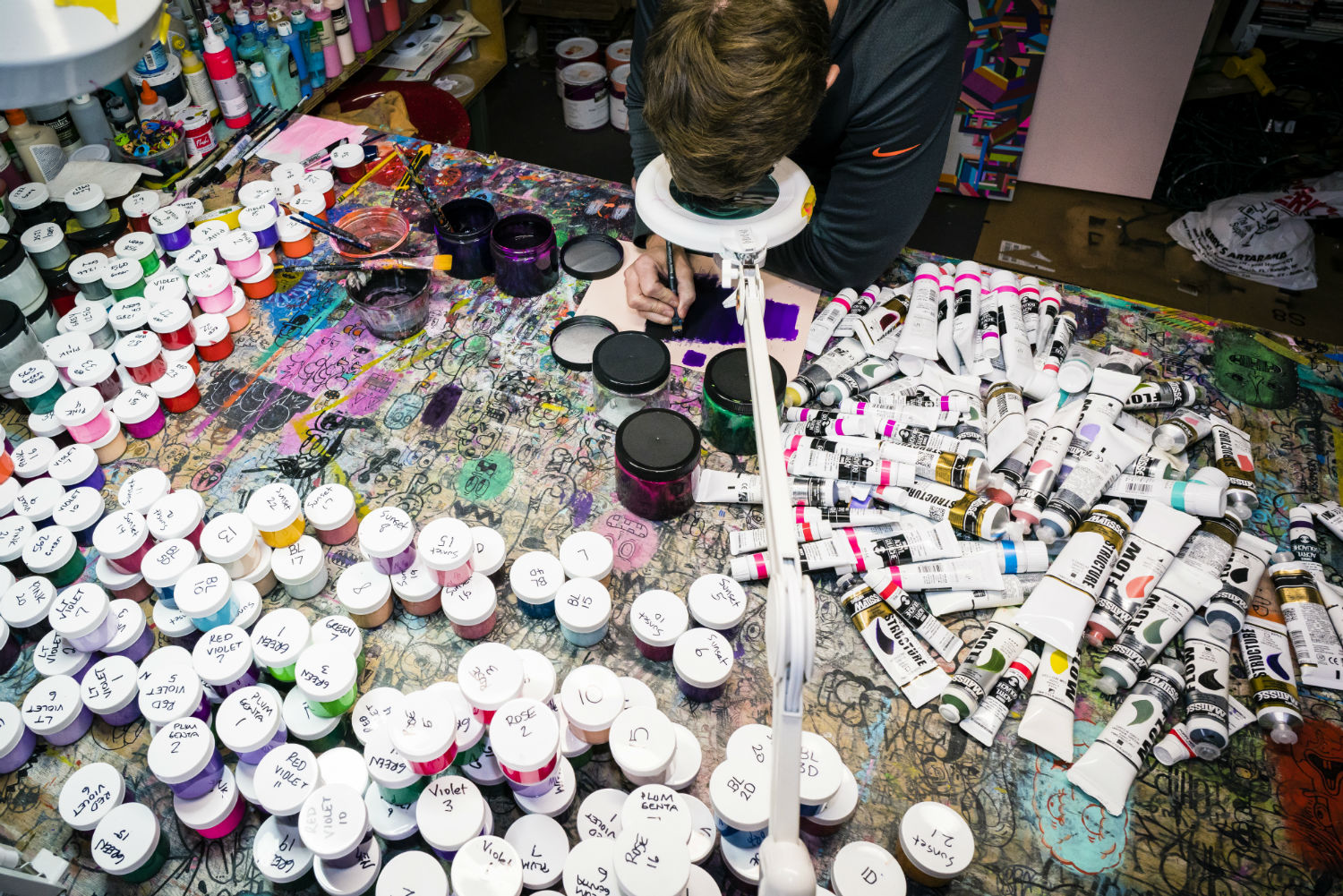
Your paintings do have a mathematical element. Do you put down pencil lines first, or do you just paint perfect lines freehand?
No, it’s all tape. There’s no way. No one in their right mind would freehand that many straight lines. I would have to be borderline institutionalized to have that level of perfection. You would have to be insane.
Right! Do you sketch?
If I’m sketching with pencil, I’m doodling characters. When I want to sketch for paintings, I’ll just work in Adobe Illustrator all day and build things, cut and paste and tile things, flip them around and recolor things. That’s my sketching.
What I’ve always struggled with is that, no matter what I did, I always hated recreating something from a computer on a canvas because I’d feel like I’d already done it. What I like about art more than anything is problem solving, and mixing colors is the ultimate problem for me now; like how can I get 30 shades of red and keep everything looking lined up so that it doesn’t get too flat, too hot, too cool? Those are huge challenges to figure out, and that’s what I like.
Do you go through phases with color? There was a lot of orange in your recent solo show at Jonathan LeVine gallery.
I was really trying to figure out how to relay that warmer, fleshier feeling. That’s what all those orange and red paintings are very much about. I was working with flesh tones to create something that’s rigid, yet organic feeling. I like the juxtaposition of rigidity and flexibility kind of co-existing. How do you take really hard-edge things and make them soft? It was an interesting problem for me to work with. I feel like I got close, and there’s room to explore. The stuff in the show was still very geometric, whereas the next step will focus on making it feel even more flowy and curvy, although when you get on top of it, there are still hard-edge lines and sharp angles.
They do feel warm.
I did a show in Oklahoma City at The Womb Gallery, that space Wayne Coyne from the Flaming Lips has. Since it was called The Womb, I wanted to make the space feel even more like a womb, and the two paintings in that recent Major Work show at Chandran Gallery were from that installation. The Womb Gallery is another perfect example because Wayne’s world (no pun intended) is very loose and flowing, and he is very organic in every aspect of his life. I’m the polar opposite. I’m as rigid as humanly possible, because the only way I can move forward is to contain my energy. It was this really cool thing of taking my approach into his world. That installation, and now this LeVine show, were the first times where I felt like my abilities with color brought me to a point where I could explore better. Instead of being able to mix 20 colors in a range, I can get about 40 without losing the differentiation. I don’t think you can go much deeper than maybe 50 while keeping only a couple degrees of separation between each color.
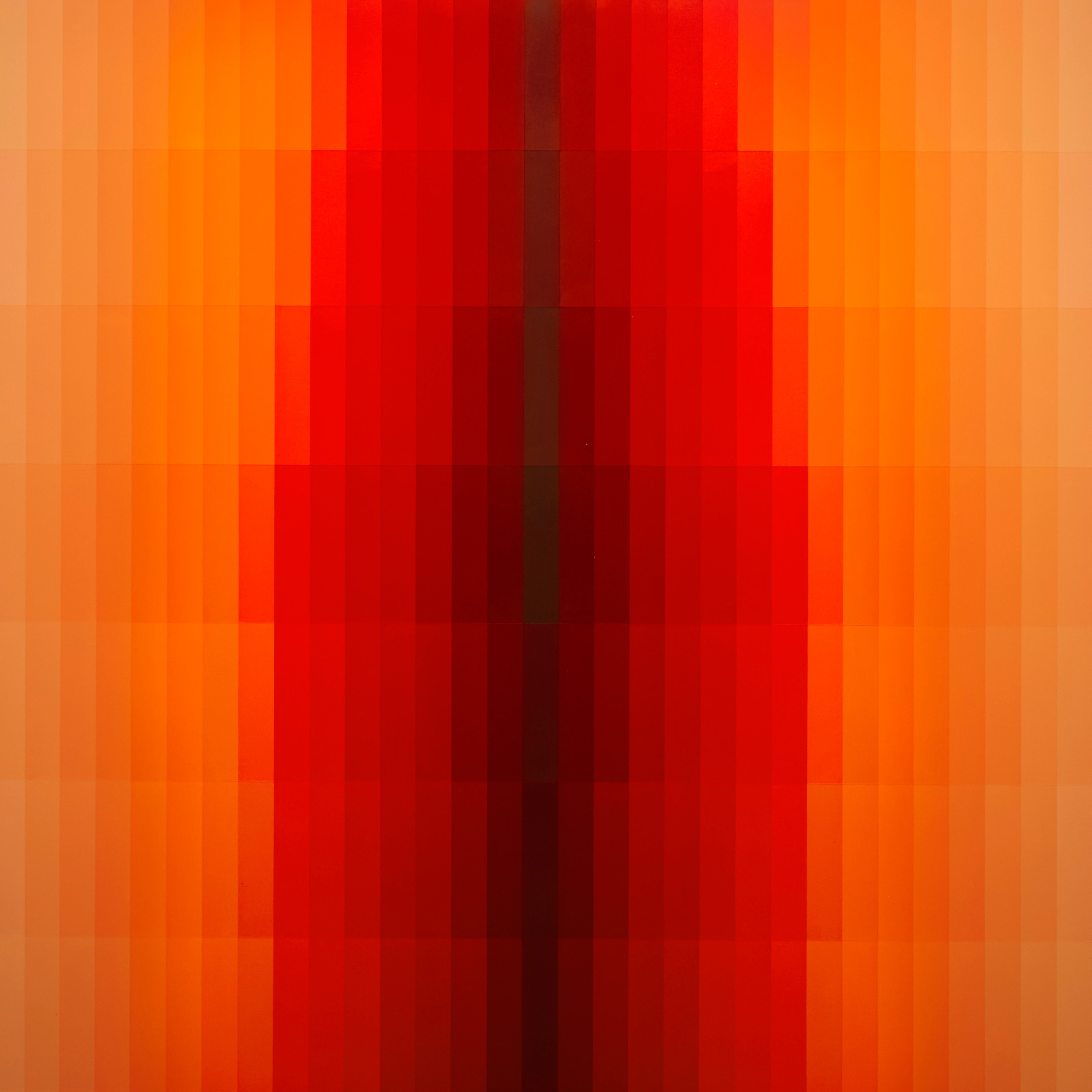
You used to outline each color in black and then you stopped.
The black line served its purpose with the Space Monkey and early geometric stuff, but I realized I was flattening things out and it wasn’t giving me the depth I wanted.
I’m still trying to teach myself the basic tenets of painting as I see them. I don’t have a formal art education, but I feel like I spent years teaching myself color. I feel like I’m well versed in it, but I still have room to push. I can comfortably say I think I could pretty much run anybody’s ass under the table when it comes to color. I know there’s a lot of people biting my shit right now, but that’s not new either. I always take it as a challenge. Look, man, if you want to come and play in my world, I’m going to up the ante. All of a sudden, everybody’s doing geometric work, and there’s a lot of motherfuckers doing color fade work. If you want to play in my kingdom, then you need to recognize that you’re ripping off my shit and I’m going to have to one up you and keep you on your toes.
I’m one of those motherfuckers! I like to paint geometrically, but I would never fuck with a color fade like you do.
I don’t mind if someone’s using it in a different way and they’re being respectful. I’m not going to say I’m the originator of this or that, but I will say that whatever I’ve done, I’ve made it my own. I take a lot of pride in that. I’m not saying I’m reinventing the wheel, but look at someone like Tarantino. He took a bunch of styles that pre-existed and combined them all together in interesting ways and made it all brand new. It was about mixing personal experiences and what appealed to him from all these old genres into something completely new but that isn’t so serious it can’t laugh at itself. Tarantino just does his own thing. He’s been hated on and clowned on, he’s been admired, but he just does what he believes in and doesn’t give a fuck. He continues to take regurgitated concepts and make them fresh.
If you can take what exists in you personal pantheon and give it some depth and newness, and some context that makes sense to who you are as an individual, and it’s an honest part of you, then I don’t have a problem with it. If you don’t have enough individual creativity to create your own lens, and then you get attention anyway…
I see galleries working with obvious biters, and I wonder if the curator is clueless.
Sometimes people are positioning themselves to pick up the overflow. Mark Ryden’s a good example. When his work got so popular and out of price, how many people in LA started painting like Mark Ryden? Everybody. People would think, “I can’t pay a quarter of a million for a Ryden so I’ll buy this other person’s work.” Artists position themselves like that, and I don’t have a problem with it if they want to take some ownership and eventually grow.
Nothing makes me madder than an artist whose work looks like it did 20 years ago. Why would I even care to see their art anymore? It was great 20 years ago, but I don’t give a shit anymore. They might be popular, if not more so today, because they’re just riding the horse. Again, that’s fine, but I’d rather go to my grave being broke and original than riding a cash whore and selling my soul for some buillshit. I just want to let honest discoveries and growth happen, and I feel that’s what is important in life—just to have that integrity.
This is an excerpt. Read the full interview in the April, 2016 issue of Juxtapoz Magazine on sale here.




